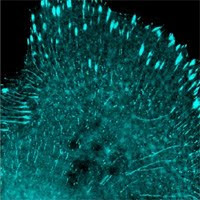http://allelebiotech.com/blogs/2010/09/3-ways-of-making-dna-libraries-through-oligo-synthesis/
Pools of DNA molecules of related but non-identical sequences are often used for selecting cDNAs that encode polypeptides with desired functions (such as in antibody screening), or DNA segments as protein binding sites (through SELEX), or DNA molecules that can catalyze reactions (DNA enzymes or deoxyribozymes), etc. The most direct way of creating DNA libraries is to introduce mixed bases during the synthesis of the oligos that will be used in creating the libraries.
1) The most commonly used method of generating degenerate oligos is to use mixed phosphoramidites (aka amidites, the building blocks of oligo synthesis) at desired positions in an oligo, e.g. using “N” to incorporate dA, dC, dG, and dT nucleotides, or “Y” for pyrimidines, “R” for purines. Mixed base oligos from most oligo suppliers are simple to order (and at no extra charge from Allele and a few other sources). During automated chemical synthesis of oligos, the synthesizer consecutively adds dT, dA, dC, or dG in the case of “N” at a pre-set ratio (e.g.25% each). This procedure does not always result in expected usage of each amidite because different amidites have different coupling efficiency, and the order of addition may also bias against amidites that are added later.
2) Using mixed bases like in method 1) leaves little control to achieve ratios of codons for specific amino acids. On the other hand, by using trimer amidites, which can be used for adding 3 nucleotides in each synthesis cycle, one can create oligos encoding selected amino acids at pre-determined percentages. However, this procedure is difficult to perform because trimer amidites are bulky and hard to couple to the elongating oligo; any moisture present during synthesis would have even more severe adverse effects than with regular amidites. Trimer oligo synthesis projects cost several thousand dollars per oligo on materials alone, and the risk is quite high that the oligos would not turn out of desired properties and qualities. For commercial users, this process has another problem—it is patented.
3) Another method for making library oligos is the so called “split-and-pool”, which is particularly suitable for having diversified amino acids embedded in otherwise common sequences like the CDRs within antibody variable regions. The latest oligo we made last month was a ~72 nt oligo with 8 locations that have pre-determined composition of amino acids, i.e. 20% Ala, 10% Gly, 12% His, etc. The procedure took us about 8 hours and we estimated the cost to be about $1,000. The subsequent sequencing results confirmed that ~70% of the clones using this oligo have desired degeneracy, compared to a similar oligo made by a bigger oligo company, at only 40%. In addition, we did not see any stop codon interruptions or major abnormalities.
DNA pools can also be generated by error-prone PCR, or more specifically with overlapping PCR using degenerate primers. The bottleneck for a library screening is how to handle big enough a number of colonies to accommodate the population, e.g. 10e10, or at least 10e8 clones are needed for finding high affinity antibodies. The second critical point is to have a robust and consistent selection readout such as fluorescence in cell sorting.
New Product of the Week 090710-091310; loxP-mWasabi reporter T cells, email vivec@allelebiotech.com for details.
Promotion of the Week 090710-091310: 15% off our NEW purified fluorescent proteins (not plasmids); All Expressed from E.coli PROMOCODE: 090910FP
Sunday, September 12, 2010
3 Ways of Making DNA Libraries through Oligo Synthesis
Labels:
antibody,
CDR,
degenerate oligos,
DNA library,
DNA primer,
fluorescence,
mixed bases,
oligo,
oligos,
split-and-pool,
trimer oligo
Subscribe to:
Post Comments (Atom)




No comments:
Post a Comment